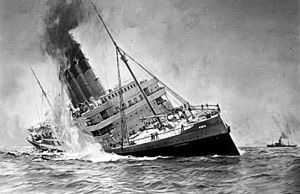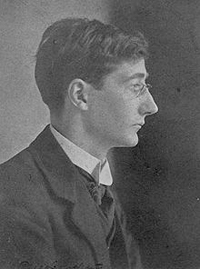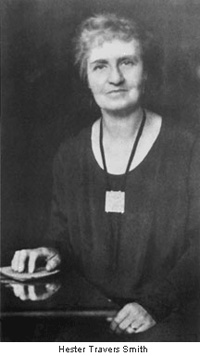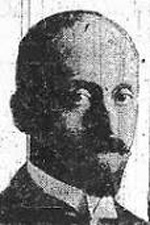Remembering the Lusitania and the Hugh Lane Messages
Posted on 04 May 2015, 10:41
Since May 7 marks the 100th anniversary of the sinking of the RMS Lusitania off the coast of Ireland (below) by a German submarine during WWI, I thought it a good time to recall some spirit communication involving that tragic event, which involved 1,198 fatalities.

On the evening of May 7, 1915, Hester (Dowden) Travers Smith, (1868-1949), a prominent Dublin, Ireland medium and wife of a respected physician, was sitting at the ouija board with Lennox Robinson, (below) a world-renowned Irish playwright. Both were blindfolded as the Rev. Savell Hicks sat between them and copied the letters indicated by the board’s “traveler.” “Pray for Hugh Lane,” was the first message received. Following the prayer request, the traveler spelled out: “I am Hugh Lane, all is dark.” At that point, however, Travers Smith and Robinson were still blindfolded and had no idea as to the message. In fact, they were conversing on other matters as their hands moved rapidly. After several minutes, Hicks told Travers Smith and Robinson that it was Sir Hugh Lane coming through and that he had communicated that he was aboard the Lusitania and had drowned.

On her way home that evening, Travers Smith (below) had heard about the sinking of the passenger ship by a German torpedo, but she had not yet read the details, nor did she or the others know that Sir Hugh Lane was a passenger on the ship sailing from New York to England. She said that she knew Lane and had heard that he had gone to New York, but it never occurred to her when she heard of the sinking that he was on board or that he was returning from New York so soon.

Although distressed by the message, they continued the sitting. Lane told them that there was panic, the life boats were lowered, and the women went first. He went on to say that he was the last to get in an overcrowded life boat, fell over, and lost all memory until he “saw a light” at their sitting. To establish his identity, Lane gave Travers Smith an evidential message about the last time they had met and talked, although when Travers Smith asked him for his cabin number on the ship as proof that it was Lane communicating, the number given to her was later discovered to be incorrect. She reasoned, however, that he was in a confused state and that it is not unusual for people to forget their cabin numbers.
“I did not suffer. I was drowned and felt nothing,” Lane (below) further communicated that night. He also gave intimate messages for friends of his in Dublin. Thirty-nine at the time of his death, Lane was an art connoisseur and director of the National Gallery of Ireland in Dublin. He was transporting lead containers with paintings of Monet, Rembrandt, Rubens, and Titian, which were insured for $4 million and were to be displayed at the National Gallery.

Lane continued to communicate at subsequent sittings, often intruding on other spirit communicators. As plans were underway to erect a memorial gallery to him, he begged that Travers Smith let those behind the movement know that he did not want such a memorial. However, he was more concerned that a codicil to his will be honored. He had left his private collection of art to the National Gallery in London, but the codicil stated that they should go to the National Gallery in Dublin. Because he had not signed the codicil, the London gallery was reluctant to give them up. “Those pictures must be secured for Dublin,” Lane communicated on January 22, 1918, going on to say that he could not rest until they were. (It has been determined that the paintings have gone back and forth between London and Dublin every six years.)
Sir William Barrett, professor of physics at the Royal College in Dublin, had the opportunity to observe and test the ouija board sittings at the home of Travers Smith. In his 1917 book, On The Threshold of the Unseen, Barrett confirmed the procedure as indicated above, including the fact that the two sitters were blindfolded. He reported that at times the traveler moved so rapidly that it was necessary to record the messages in shorthand. Although Barrett had no doubt as to the honesty and integrity of Travers Smith and Robinson, he designed special eye patches for them to wear so that there could be no question as to them seeing where the traveler was pointing. On one occasion he turned the board around to see if the results would be the same. They were. On another occasion, to satisfy a skeptical observer, who theorized that the blindfolded operators had memorized the position of the letters on the board, the letters were rearranged and a screen was put between the two operators who remained blindfolded. Still, coherent messages came.
When Barrett asked the controlling spirit if any friend of his could send a message, he heard from a deceased friend, who sent a message to the Dublin Grand Lodge of Freemasons, of which he (the friend) had been a high ranking member. Barrett was reasonably certain that neither of the board operators was aware of the friend’s Masonic affiliation.
On another occasion, Barrett sat at the board, securely blindfolded. He reported that he was startled by the “extraordinary vigor, decision, and swiftness with which the indicator moved.” The only message that came through was one that said Barrett was not suited for receiving. In other words, he did not have the mediumistic psychic power necessary to adequately receive messages.
Before one sitting, Travers Smith and Barrett discussed how evidential the messages from Lane were to them, although they could understand why the public doubted. After the sitting started, a man who said he had died in Sheffield communicated first. Then, Travers Smith recalled, Robinson’s arm was seized and driven about so forcibly that the traveler fell off the table more than once. It was Lane, who was upset because of the doubts expressed relative to his communication.
W. B. Yeats, the famous poet, also reported contact with Lane, his close friend, through a medium in London. He said that the medium told him that a drowned man followed him into the room and then went on to describe a scene at the bottom of the sea.
In the Appendix of his 1916 classic, Raymond or Life and Death, Sir Oliver Lodge tells of a friend bringing one of the Lusitania survivors for a visit to his home. Lodge was fascinated with the woman’s account of the ordeal. “I found her a charming person, and she entered into the matter with surprising fullness, considering that she was a complete stranger,” the distinguished British physicist and educator wrote.
The woman recalled being sucked down by the ship, then coming to the surface with the feeling of blank surprise at the disappearance of the huge vessel. Lodge found her account so interesting that he later wrote to her and asked her if she would write down in as much detail as possible her recollection of the event so that he could include it in the book. The woman complied, but asked that her name not be disclosed.
“I have always remembered the sympathy with which you listened to me that morning at Egdbaston, and sometimes wondered at the amount I said,” the survivor responded to Lodge, “as it is not easy to give expression to feelings and speculations which are only roused in critical moments in one’s life. What you ask me to do is not easy, as I am only one of those who are puzzling and groping in the dark – while you have found so much light for yourself and have imparted it to others.”
The woman recalled having a premonition of the tragedy. “It was not a very actual knowledge, but I was conscious of a distinct forewarning, and the very calmness and peace of the voyage seemed, in a way, a state of waiting for some great event. Therefore, when the ship was rent by the explosion, I felt no particular shock, because of that curious inner expectancy.”
She put down her book and went to the other side of the ship where many passengers were gathering around the life boats with no panic whatsoever. The ship was listing heavily and it was already difficult to stand. She returned to her cabin, where a steward helped her put on a life-jacket and advised her to discard her fur coat. “I felt no hurry or anxiety, and returned on deck, where I stood with some difficulty.”
The woman remembered talking to an elderly man about their chances of survival. “It was then I think we realized what a strong instinct there was in some of us – not to struggle madly for life – but to wait for something to come to us, whether it be life or death; and not to lose our personality and become like one of the struggling shouting creatures who were by then swarming up from the lower decks and made one’s heart ache.” She wondered if the “grim calmness” was part of some “desire to die” instinct.
“I never felt for a moment that my time to cross over had come – not until I found myself in the water – floating farther and farther away from the scene of wreckage and misery – in a sea as calm and vast as the sky overhead.” Behind her, she heard the cries of others, the splashing of oars, and the calls of those doing rescue work from the lifeboats. “There seemed to be no possibility of rescue for me, so I reasoned with myself and said, ‘The time has come – you must believe it – the time to cross over’ – but inwardly and persistently something continued to say, ‘No, not now.’”
Continuing to drift away from the pandemonium, the woman observed gulls flying overhead and took note of the blue shadows the sea threw up from their white feathers. She began to feel lonely as her thoughts turned to her loved ones who were awaiting her arrival. “The idea of their grief was unbearable, and I had to cry a little.” She recalled the names of books rushing through her brain, especially one titled “Where no Fear is” as representing her feelings at the time. “Loneliness, yes, and sorrow on account of the grief of others – but no fear. It seemed very normal – very right – a natural development of some kind about to take place. How can it be otherwise, when it is natural? I rather wished I knew some one on the other side, and wondered if there are friendly strangers there who come to the rescue.”
The woman recalled feeling “near the borderline” when a lifeboat came up behind her and two men bent down to lift her in. “It was extraordinary how quickly life came rushing back; everyone in the boat seemed very self-possessed, although there was one man dead and another losing his reason. One woman expressed a hope for a cup to tea.”
A minesweeper from Queenstown soon picked them up. “I am glad to have been near the border,” the woman concluded her remarks to Sir Oliver, “to have had the feeling of how very near it is always – only there are so many little things always going on to absorb one here.
“Others on that day were passing through a Gate which was not open for me – but I do not expect they were afraid when the time came – they too probably felt that whatever they were to find would be beautiful – only a fulfillment of some kind…I have reason to think that the passing from here is very painless – at least where there is no illness. We seemed to be passing through a stage on the road to Life.”
Michael Tymn is the author of The Afterlife Revealed: What Happens After We Die is published by White Crow Books. His latest book, Resurrecting Leonora Piper: How Science Discovered the Afterlife is now available on Amazon and other online book stores.
His latest book Dead Men Talking: Afterlife Communication from World War I is published by White Crow Books.
Next blog: May 18
|